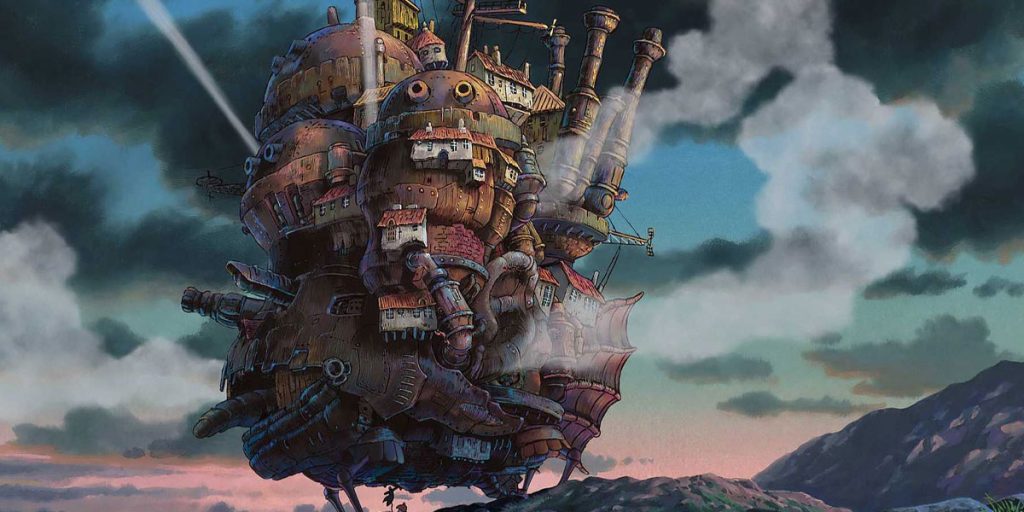Hayao Miyazaki’s endeavour to achieve perfection and attention to detail find their apex in Howl’s Moving Castle, Studio Ghibli’s most eccentric and intense masterpiece.
Animated by Studio Ghibli in 2004, Howl’s Moving Castle (Howl no Ugoku Shiro) is Studio Ghibli’s founder Hayao Miyazaki’s ninth feature. Loosely based on Diana Wynne Jones’s book of the same name, not only has it become one of the most successful Japanese films in history, but it is also Studio Ghibli’s second highest grossing picture, second only to Spirited Away, another Studio Ghibli gem which is currently the highest-grossing animated film in Japan to date. Despite condensing the book’s plot and making major changes to parts of it, this is not the usual case where the magic and beauty of your favourite book is killed in the movie adaptation. In fact, it’s quite the opposite.
Diana Wynne Jones herself loved the movie, and praised Miyazaki for turning her pages into the beautiful visual artwork that it is, actually saying “I was thrown back in my seat with amazement” – confessing that she was particularly fond of the breakfast scene and the look of Howl’s Castle, which is slightly different from the book’s version.
The book and the movie are two shining gems in their own right in the literature and animation world, and can be truly appreciated independently of one another.
As it is in most of the best fairy-tales that have been read to us as children, Howl’s Moving Castle involves a curse, a strong female protagonist, a villain, a charming wizard, badass side characters and the most fascinating element of the movie: the moving Castle. The Castle is actually a character itself in its cluttered, mismatched Steampunk-meets-Harry Potter-style, and we are introduced to it at the very beginning in a wonderful establishing shot, where the Castle is coming through from a dense cloaking fog hopping on its two chicken legs. This opening frame is Miyazaki’s most used opening shot. It has been in many other Studio Ghibli movies, most notably in Nausicaa in the Valley of the Wind (1984) and Laputa – Castle in the Sky (1986), where we follow a foreign, almost alien object appearing from a distance on a natural setting (nature is always an essential silent character in all Studio Ghibli’s movies).
Our main female character is Sophie Hatter (voiced by Emily Mortimer and Jane Simmons in the English version) a shy, introverted hat maker living in a lovely country named Ingary – a town that was inspired by the look of the actual real town of Colmar in France. Her life is quiet, and she is pretty much stuck into a boring little town routine. That is, until she meets Howl, a childish and mischievous Wizard (voiced by Christian Bale, who’s a huge fan of the brilliant Miyazaki) who is responsible for setting the story in motion and for changing Sophie’s life to a magical adventure.
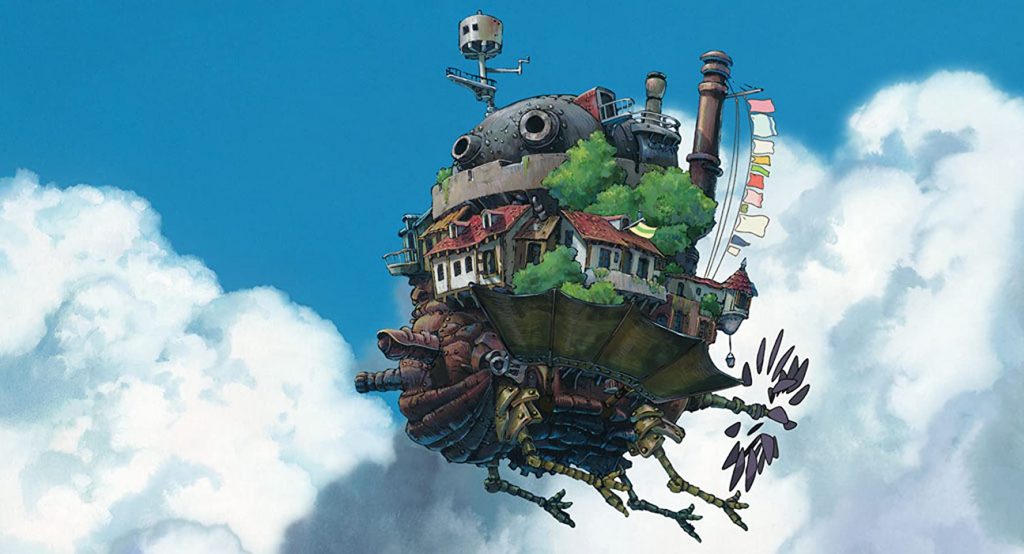
A pop and slightly vain version of the more classic Peter Pan, Howl is a sublime expression of personal growth, as he is a charming, stubborn character who refuses to grow up and take on responsibilities, though he is ultimately kind at heart – an aspect that Sophie is aware of from the very beginning. However, Howl is also indirectly responsible for having Sophie cursed by the Wicked Witch of the Waste who, jealous of the attention he has for Sophie, turns her into an old woman.
Inside the Castle with Howl live Calcifer (Billy Crystal), a Fire Demon bound in a magical contract with him and who is also the source of the Castle’s magic, and Markl (voiced by Josh Hutcherson), his young apprentice. The protagonists embark on an adventure to find a way to restore Sophie’s youth. As seen before in many of Miyazaki’s movies, war serves as backdrop setting and moral thread for this parable, adding moral gravity to the colourful images on screen, as always one of Miyazaki’s trademarks.
Howl’s Moving Castle is definitely one of Miyazaki’s most complex and layered creations, where the coming-of-age theme actually has adult and complex tones. This grown-up adventure is heavily interwoven with anti-war feelings, openly shared by Miyazaki himself – the talented director has been relentlessly threading pacifist messages in his movies since the beginning of his career, and this one is no exception.
It is clear that overcoming fears, identity and self-worth are pivotal elements in all Studio Ghibli movies, as well as recurrent motifs of compassion, love, sacrifice and self-discovery; this makes Howl’s Moving Castle not only a wonderfully timeless movie, but an ageless one too.
For the heathens not yet in love with Miyazaki’s work, it must be mentioned that details and character design are extremely important to this filmmaker, and they are directly interrelated with two pivotal elements in the story: emotional and personal growth. Howl’s Moving Castle is the perfect example of a film where we can clearly see and understand the personal development of each character from the inside-out.
All characters in the movie undergo physical and emotional transformation, whether through a curse, by magic, through the aid of disguise or all these combined. For instance, Sophie is turned into an old woman by the witch of the Waste, and Markl disguises himself as an old man. Howl’s most iconic visual transformation is into a huge bird, and the Witch of the Waste uses her magic to glamour herself first into a younger looking woman and then, when deprived of all her magic, into an old, helpless version of herself. These transformations flow into the visual narrative so beautifully, enriching the tale with numerous magical elements and, more importantly, adding layers to these characters forging a deeper emotional connection to the story and the protagonists themselves.
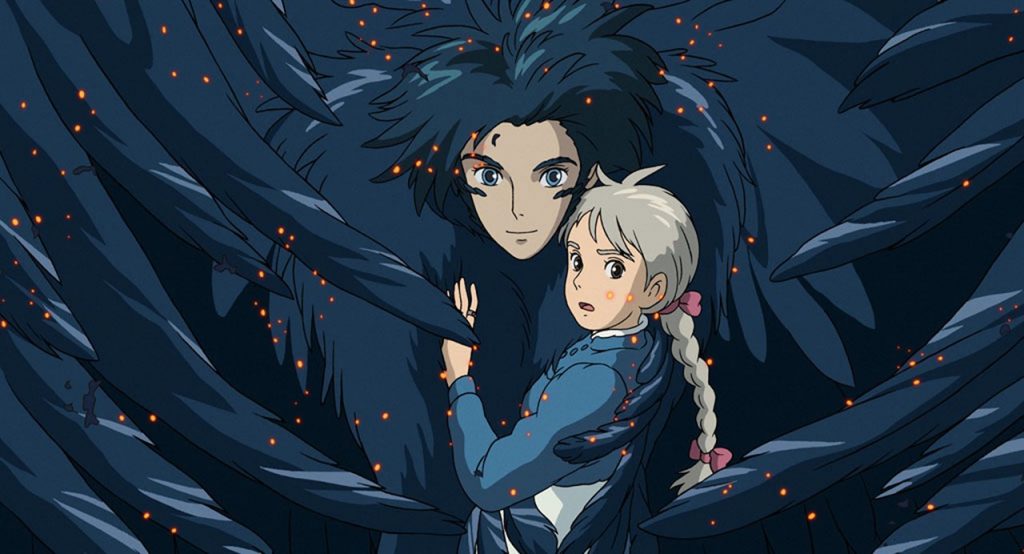
Howl’s wardrobe alone makes him the best designed character of all Miyazaki’s movies, but Sophie is the more obvious and complex example of character development, and this is extremely clear in several plot points. When we are first introduced to Sophie, she is a shy, introverted girl, wearing plain clothes in dull colours to reflect her own feelings. Throughout the movie, we see her shift and bloom, and she turns into a more assertive and passionate young woman. To reflect that, her character design changes as well: as we approach the end the end of the movie, she wears dresses and accessories in brighter colours, her hair is worn differently and her gestures, still as delicate as they were at the beginning, are now also self-assured and more confident.
This change is foreshadowed earlier in the film, when she is able to momentarily turns young again by drawing into her own confidence and capacity to love. At the same time, when she turns into an old lady, we also see her somehow carrying that wisdom, patience and compassion that only come with age, after a lifetime of experience and struggles: her expressions and gestures manage to show that to us. I feel that one the greatest points of the movie is that Sophie is no damsel in distress: she is very much her own hero, and she “saves herself”, showing she is a true match for the powerful Howl.
A lot of the beauty of the story is that there is s no clear line between ‘good’ and ‘evil’ as such: each character is multi-layered and either evolves morally throughout the movie or is able to redeem themselves like Calcifer, Howl and the Witch Of The Waste, who change from being the evil antagonist to a loveable side character, someone we cannot help developing compassion for, exactly like Sophie does in her journey.
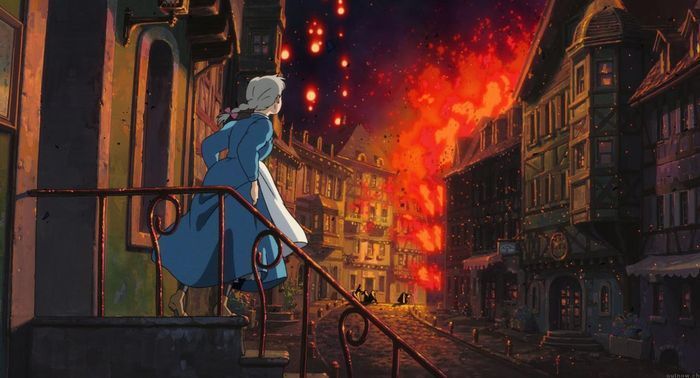
Howl’s Moving Castle is, with no doubt whatsoever, Miyazaki’s cinematic protest against the Iraq war, making it Studio Ghibli’s darkest movie. For instance, we are never told the name of the neighbouring Kingdom that Ingary is waging war to, because it doesn’t really matter: we know what country it is. Miyazaki has been vocal about it: to make his point, he didn’t show up at the 2003 Academy Awards to collect his Oscar for Spirited Away, stating that he “didn’t want to visit a country that was bombing Iraq”, and his feelings couldn’t have been clearer.
However, the movie also displays hints of lightness despite its anti-war core’s darkness and the real world’s emotional nuances. These brighter nuances are finely expressed in his world of fantasy, where he masters colourful palettes and music – scored by Joe Hisaishi – adding joy and happiness to grave and sad scenes. Apparently aimed for children, Miyazaki’s movies carry the weight of the grown-up world’s responsibilities and hardships, war being the most devastating calamity of all. Miyazaki said he believes that “children remember things better when they are younger” and so his movies will always bear a mature tone.
At the end of the movie, as many other fans have, I was left with some questions, mainly about the magic used by Sophie and her powers. Was, then, love (and, perhaps, compassion) the real act of magic? Were those Sophie’s actual powers, and what served her in the end to break the curse and help her become the confident woman Howl falls for? Would Sophie have reverted into an old lady again, as her curse intended her to, had she doubted herself and her own worth again? Even though she didn’t believe so, she was indeed worthy and beautiful all along: perhaps the curse cast upon her showed her just that, that her confidence and ability to love were her “magical powers”.
Miyazaki reminds us, once again, that Love is the ultimate force of change, and no other animated movie has ever been able to capture its essence as honestly and vividly as Howl’s Moving Castle.
Howl’s Moving Castle is now available to watch on digital and on demand. Read our review of Princess Mononoke.
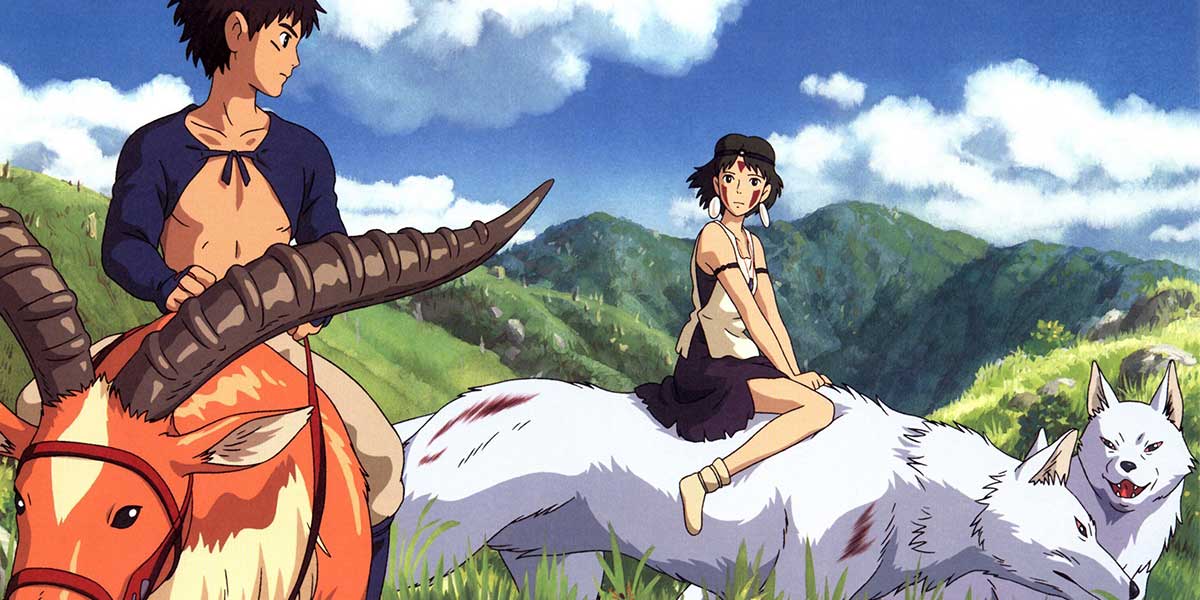
 loudandclearreviews.com
loudandclearreviews.com
